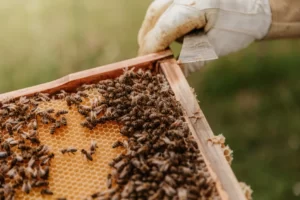Table of Contents
Honey production in bee colonies can vary, even when they are in the same apiary with the same conditions and flora. This variation is often due to differences in bee strains and the quality of the queen in each colony. Beekeepers have the ability to change the strain of bees in a colony by requeening, which involves replacing the queen with a queen of the desired strain. This procedure is also used to replace old or low-performing queens.
Laying queens can be purchased from queen breeders or reared by experienced beekeepers who have a good understanding of bee behavior, handling, and beekeeping techniques. However, it is important for those who are inexperienced in handling bees to read up on safe beekeeping practices and wear adequate protective clothing, including a bee veil, before opening hives.
Natural Queen Raising by Honey Bees
Queens and worker bees are raised from the same fertilized female eggs. When a female larva hatches, it is neither a queen nor a worker. The composition of the royal jelly fed to the larvae destined to be queens or workers differs slightly, starting from the time of hatching. On the third day after hatching, worker larvae are fed a diet that includes pollen.
To obtain good queens, it is crucial to use larvae under the age of 24 hours for rearing. These larvae have had minimal exposure to a worker diet. Queen cells, which are near-vertical, peanut-shaped beeswax cells with a downward-facing opening, are built by honey bee colonies specifically for raising queens. These cells are not always present in the hive and are only built when needed.
During natural queen raising, the queen may lay an egg in the cell cup before the worker bees fully build the walls of the cell. This process does not apply when bees raise queens under emergency circumstances.
The following natural impulses stimulate the building of queen cells and the raising of queens:
1. Queenlessness (emergency): When a colony loses its queen, an emergency situation arises, and the bees raise new queens as quickly as possible. Worker cells containing larvae are modified to become queen cells, and these larvae may be fed worker royal jelly for some time, resulting in queens with reduced egg-laying capacity.
2. Swarming (reproduction) and supersedure (replacement): When a colony is preparing to swarm or needs to replace an old or deteriorating queen, eggs are laid in queen cell cups built by the bees on the surface or edge of the comb. Queens raised under these impulses are usually well-developed with good egg-laying potential.
The supersedure impulse can also be triggered by the beekeeper to raise a large number of quality queens in a controlled manner.
Requirements for Good Queens
Successful queen raising requires the following:
- Ample supply of nectar and high-quality pollen.
- Abundance of sexually mature, high-quality drones for mating with the newly emerged virgin queens.
- Suitable weather conditions for drone and queen mating.
- Suitable starter and cell-raising colonies.
- A queen mother with ideal characteristics, such as gentle temperament, disease resistance, low swarming tendency, and excellent honey production, to breed from.
Please note that genetics and selection of suitable drone and queen mothers for breeding bees go beyond the scope of this article. For more information on these subjects, refer to the suggested reading list at the end of this article.
Summary of Steps for Queen Raising
Queen raising involves the following stages:
- Establishing a starter colony for the initial stage of raising queen cells.
- Establishing the cell-building colony.
- Grafting honey bee larvae.
- Transferring mature queen cells to honey bee nucleus colonies for the mating stage.
The Starter Colony
Choose a strong, two-storey colony with a two-year-old queen. Move the queen and the comb she is on, along with the bees, to a spare empty eight-frame box or nucleus hive. Place the two-storey hive about two meters behind the original site.
Prepare the starter colony by placing an empty box with a bottom board and lid on the now vacant site. Transfer four combs of unsealed brood with adult bees from the two-storey hive to the empty box.
Place a comb of unsealed honey and pollen with bees on each side of the brood. Fill the gaps in the box with empty combs.
Add extra young bees to the starter colony by shaking bees from another two or three combs, preferably brood combs, from the two-storey hive.
Add a feeder of sugar syrup to the starter colony. The state of queenlessness will stimulate the nurse bees in the starter colony to produce more brood food.
Return the queen and the comb she is on to the bottom box of the two-storey hive.
The Cell Builder Colony
The aim of this procedure is to trigger the supersedure impulse, under which bees will carefully nurture the developing queens.
When selecting cell builder colonies, avoid those headed by very young queens. Choose strong colonies that fully occupy at least double-storey hives. A three-box colony can be temporarily reduced to two boxes of space.
Use an excluder to confine the queen to the bottom box. This brood chamber should contain a balanced amount of brood and empty drawn comb for the queen to lay eggs.
Place two combs of very young larvae in the center of the super. Fill the remaining space with combs of honey and pollen.
Ensure that combs of unsealed honey and pollen are placed alongside the frames of unsealed larvae to simulate a natural brood nest.
The excluder prevents the queen from occupying the super, and nurse bees are recruited to feed the unsealed larvae in the super.
To introduce freshly grafted or started cells for rearing, lift the unsealed brood into the super with the nurse bees adhering to the comb. The bees in the super will recognize that their queen is not occupying the new brood nest and respond to the natural supersedure impulse. This is the environment in which the cells can be introduced.
Leave a gap between the two brood combs in the super wide enough to accommodate the cell bar.
When inserting the cell bar of freshly grafted larvae or started queen cells, lower it gently through the clustered bees.
Avoid rearing queens during heavy honey flows. Light nectar flow and abundant pollen provide the best field conditions.
Leave the cell-building colony for at least 24 hours before inserting started or freshly grafted cells.
If supplementary feeding becomes necessary for the cell-building colony, use sugar syrup to simulate nectar. Never use diluted honey.
Grafting
Prepare the bars of cells by attaching 20 plastic cell cups to a waxed bottom bar of a half-depth frame or a homemade wooden cell bar. Place the bar in a hive at least 24 hours before grafting to allow the bees to clean and condition the cell cups.
Use a grafting tool to transfer larvae onto the bottom of the cell cup. The tool should follow the curve of the cell bottom, allowing the larvae to be inserted without touching it.
Under optimal conditions, pre-priming the cell cups with diluted royal jelly is not necessary, particularly for modest numbers of cells. Graft larvae that are under 24 hours old and floating on a good amount of royal jelly.
Grafting can be done indoors under good artificial light or in the open, as long as atmospheric conditions are suitable. Avoid exposing the larvae to direct sunlight and work quickly.
Remove the frame of larvae from the breeder colony when ready to graft. Carefully brush off the bees and carry it to the grafting location.
Position the frame so that the light falls into the cells (avoiding direct sunlight) and allows for easy removal of the larvae.
Shave the cells down to about half depth using a safety razor with the rake removed. The hot blade of the razor will slice the tops off the cells quickly and cleanly.
Transfer the larvae to the prepared cell cups using the grafting tool:
- Slide the grafting tool, in the vertical position, close to the worker cell wall under the floating larva.
- Lift the larva out of the cell.
- Place the larva into the queen cell by drawing the tool across the cell base.
After grafting, remove the combs of brood from the starter hive and shake the bees back into the hive. Return the brood combs to the super of the two-storey hive.
Insert the bar of cells into the starter colony, ensuring the larvae do not dehydrate. Leave the bar of cells in the starter colony until the next morning. Four bars of cells are sufficient; do not overload the starter colony.
On the morning of day 1 after grafting, remove the bars of cells from the starter hive. The acceptance of cells on each bar may vary, depending on the care and skill of the operator.
Cull any cells that have larvae bigger than the others or do not appear to be well-fed. The best queens are obtained by reducing the number of cells to no more than 15 per bar.
Open the cell builder hive and create a space between the two brood combs in the super. Place each bar of started cells with adhering bees in this space, taking care not to shake or knock the bar. Replace and refill the feeder, continuing light feeding until the cells are sealed (four days after inserting the cell bars).
Additional bars of cells can be grafted and given to the starter colony. If the starter colony is not needed for starting more cells, it can be reassembled in its original form.
Experienced queen breeders may be able to transfer freshly grafted material directly into the cell-building colony without using a starter colony, achieving successful acceptance percentages.
Records and Emergence of Queens
Keep a record of the day the cells were grafted and the day the queens are due to emerge. This can be done using marks on hives, bars, and frames, recorded in a notebook.
Queens emerge 16 days after the egg is laid or 13 days after the egg hatches into a larva. If a larva under 24 hours old is grafted, a young queen will emerge 12 days later.
Ideally, cells should be left until the day before they are due to emerge before being removed from the cell-building colony and distributed to nuclei. However, this timing could be risky if one larva is older than the others and a virgin queen emerges before the cells are removed. Cells can be safely given to nuclei on day 12 after the egg was laid or even earlier if handled carefully.
Transport and Distributing the Cells
Cells must be handled gently to prevent damage to the immature queens. Avoid shaking or jarring combs or bars with cells and try to keep them in their natural perpendicular position.
Prevent exposure to hot, direct sunlight, as the queen nymph is susceptible to chill. Do not leave the cells out of the hives for an extended period and avoid exposure to cold winds or a chilly atmosphere.
When transporting, several bars of cells can be placed in a single cell-carrying hive. This can be a hive used for cell building or a nucleus box moderately filled with bees from a cell builder hive, without a queen. Ensure that the cell-carrying hive is not overcrowded, as this can cause the cells to overheat.
Cells should be put out as soon as possible after the nucleus colonies are set up in the mating yard. If too much time elapses, the nuclei may start building their own cells, which should be destroyed before inserting the raised cells. Additionally, adult bees may become discontented and prone to drifting. In hot weather, wait until the cool of the evening before distributing the cells.
Give one cell per nucleus. Use a wet sharp knife to separate adjoining cells on the cell bar. Stand the top bar of the frame holding the bar(s) of cells uppermost.
Carefully pry each cell from the bar and place it straight into a nucleus hive. Remove a side comb from the nucleus to make room for manipulation and press a slight depression into the face of the center brood comb. Gently press the plastic base of the cell into the depression.
Each nucleus should be marked with the date the young queen is due to emerge and the queen from which she was bred. Under normal field and mating conditions, a virgin queen will mate and begin laying eggs about 10 days after emerging from her cell. In the autumn, this period can be extended. Avoid opening or moving nucleus hives during the mating period.
Mating of Virgin Queens
Mating of virgin queens takes place when they are flying in the open, not inside the hive.
A virgin queen will take one or more orientation flights a few days after emerging from her cell to mark the location of the hive. Mating occurs when the virgin queens are sexually mature, usually between 5 to 6 days after emergence.
If a virgin queen is confined to the hive for more than 20 days due to unfavorable weather or wing damage, or if she is unable to mate successfully, she will remain infertile and become a drone layer.
Most queen rearers will destroy queens that fail to lay on time, except in the autumn when mating and expected laying time can be extended due to cooler temperatures.
Further Reading
- “The Hive and the Honey Bee” (1992) edited by J. Graham. Published by Dadant and Sons, Hamilton, Illinois, USA.
- “Queen Rearing” (1962) by H. Laidlaw and J. Eckert. University Press, Berkeley, California, USA.
- “Queen Rearing” (1981) by L. Snelgrove. Published by Snelgrove and Smith, Avon, UK.
Adapted from the chapter ‘Queen raising and requeening’ from the book ‘Beekeeping’ by John McMonigle, former apiary inspector. Linton Briggs, queen rearer, Glenrowan, Victoria, supplied Figure 1 and contributed to the original text.



